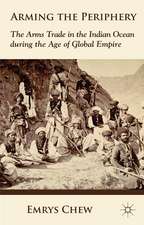Ethnographic Plague: Configuring Disease on the Chinese-Russian Frontier
Autor Christos Lynterisen Limba Engleză Hardback – 11 aug 2016
| Toate formatele și edițiile | Preț | Express |
|---|---|---|
| Paperback (1) | 691.45 lei 6-8 săpt. | |
| Palgrave Macmillan UK – 10 iun 2018 | 691.45 lei 6-8 săpt. | |
| Hardback (1) | 695.85 lei 6-8 săpt. | |
| Palgrave Macmillan UK – 11 aug 2016 | 695.85 lei 6-8 săpt. |
Preț: 695.85 lei
Preț vechi: 818.64 lei
-15% Nou
Puncte Express: 1044
Preț estimativ în valută:
133.15€ • 145.22$ • 112.27£
133.15€ • 145.22$ • 112.27£
Carte tipărită la comandă
Livrare economică 25 aprilie-09 mai
Preluare comenzi: 021 569.72.76
Specificații
ISBN-13: 9781137596840
ISBN-10: 1137596848
Pagini: 196
Ilustrații: XIX, 199 p. 3 illus.
Dimensiuni: 148 x 210 x 18 mm
Greutate: 0.39 kg
Ediția:1st ed. 2016
Editura: Palgrave Macmillan UK
Colecția Palgrave Macmillan
Locul publicării:London, United Kingdom
ISBN-10: 1137596848
Pagini: 196
Ilustrații: XIX, 199 p. 3 illus.
Dimensiuni: 148 x 210 x 18 mm
Greutate: 0.39 kg
Ediția:1st ed. 2016
Editura: Palgrave Macmillan UK
Colecția Palgrave Macmillan
Locul publicării:London, United Kingdom
Cuprins
Introduction: Plague Beyond the Laboratory. - 1. The Native Knowledge Hypothesis. - 2. Medical Myths and Mythic Medicine. - 3. Ethno-Geographic Entanglements. - 4. Anthropological Types and Clustered Hypotheses. - Conclusion: Ethnographic Data as Medical Evidence.
Notă biografică
Christos Lynteris is a social anthropologist working on biopolitical and visual aspects of infectious disease epidemics. He is Senior Research Associate at CRASSH, University of Cambridge, UK, and Principal Investigator of the European Research Council funded project Visual Representations of the Third Plague Pandemic. He is also the author of The Spirit of Selflessness in Maoist China (2012).
Textul de pe ultima copertă
Challenging the concept that since the discovery of the plague bacillus in 1894 the study of the disease was dominated by bacteriology, Ethnographic Plague argues for the role of ethnography as a vital contributor to the configuration of plague at the turn of the nineteenth century. With a focus on research on the Chinese-Russian frontier, where a series of pneumonic plague epidemics shook the Chinese, Russian and Japanese Empires, this book examines how native Mongols and Buryats came to be understood as holding a traditional knowledge of the disease. Exploring the forging and consequences of this alluring theory, this book seeks to understand medical fascination with culture, so as to underline the limitations of the employment of the latter as an explanatory category in the context of infectious disease epidemics, such as the recent SARS and Ebola outbreaks.









